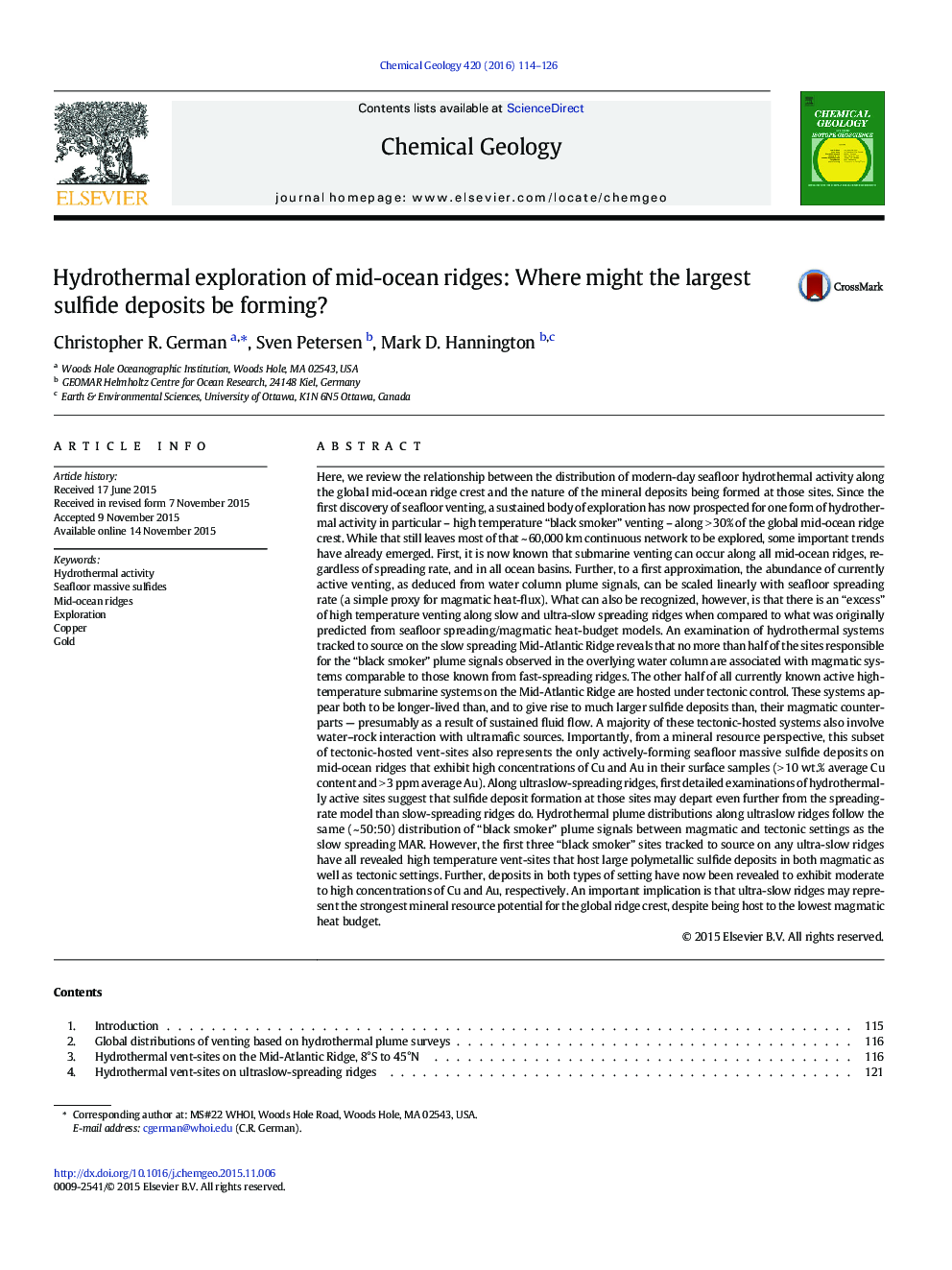| کد مقاله | کد نشریه | سال انتشار | مقاله انگلیسی | نسخه تمام متن |
|---|---|---|---|---|
| 4698345 | 1637554 | 2016 | 13 صفحه PDF | دانلود رایگان |
• “Black Smokers” on slow-spreading ridges can host larger seafloor massive sulfide (SMS) deposits than on fast ridges.
• The largest slow-ridge SMS deposits are typically associated with long-lived tectonic fractures ± sustained fluid flow.
• Ultramafic-, tectonic-hosted sites exhibit high average Cu (> 10wt.%) and Au (> 3ppm) contents in their surface SMS samples.
• Hydrothermal plume surveys are consistent with equal abundances of magmatic vs tectonic vent-control along ultraslow ridges.
• The first “Black Smokers” on any ultraslow ridges exhibit high Cu ± Au SMS contents at both magmatic and tectonic vent-sites.
Here, we review the relationship between the distribution of modern-day seafloor hydrothermal activity along the global mid-ocean ridge crest and the nature of the mineral deposits being formed at those sites. Since the first discovery of seafloor venting, a sustained body of exploration has now prospected for one form of hydrothermal activity in particular – high temperature “black smoker” venting – along > 30% of the global mid-ocean ridge crest. While that still leaves most of that ~ 60,000 km continuous network to be explored, some important trends have already emerged. First, it is now known that submarine venting can occur along all mid-ocean ridges, regardless of spreading rate, and in all ocean basins. Further, to a first approximation, the abundance of currently active venting, as deduced from water column plume signals, can be scaled linearly with seafloor spreading rate (a simple proxy for magmatic heat-flux). What can also be recognized, however, is that there is an “excess” of high temperature venting along slow and ultra-slow spreading ridges when compared to what was originally predicted from seafloor spreading/magmatic heat-budget models. An examination of hydrothermal systems tracked to source on the slow spreading Mid-Atlantic Ridge reveals that no more than half of the sites responsible for the “black smoker” plume signals observed in the overlying water column are associated with magmatic systems comparable to those known from fast-spreading ridges. The other half of all currently known active high-temperature submarine systems on the Mid-Atlantic Ridge are hosted under tectonic control. These systems appear both to be longer-lived than, and to give rise to much larger sulfide deposits than, their magmatic counterparts — presumably as a result of sustained fluid flow. A majority of these tectonic-hosted systems also involve water–rock interaction with ultramafic sources. Importantly, from a mineral resource perspective, this subset of tectonic-hosted vent-sites also represents the only actively-forming seafloor massive sulfide deposits on mid-ocean ridges that exhibit high concentrations of Cu and Au in their surface samples (> 10 wt.% average Cu content and > 3 ppm average Au). Along ultraslow-spreading ridges, first detailed examinations of hydrothermally active sites suggest that sulfide deposit formation at those sites may depart even further from the spreading-rate model than slow-spreading ridges do. Hydrothermal plume distributions along ultraslow ridges follow the same (~ 50:50) distribution of “black smoker” plume signals between magmatic and tectonic settings as the slow spreading MAR. However, the first three “black smoker” sites tracked to source on any ultra-slow ridges have all revealed high temperature vent-sites that host large polymetallic sulfide deposits in both magmatic as well as tectonic settings. Further, deposits in both types of setting have now been revealed to exhibit moderate to high concentrations of Cu and Au, respectively. An important implication is that ultra-slow ridges may represent the strongest mineral resource potential for the global ridge crest, despite being host to the lowest magmatic heat budget.
Journal: Chemical Geology - Volume 420, 20 January 2016, Pages 114–126
